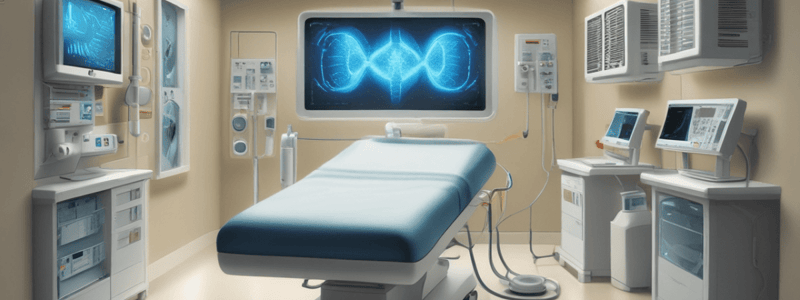Podcast
Questions and Answers
What is the primary function of M-mode in ultrasound?
What is the primary function of M-mode in ultrasound?
To isolate a single line and follow changes over time
What type of ultrasound is focused on a specific area or question and does not replace comprehensive exams?
What type of ultrasound is focused on a specific area or question and does not replace comprehensive exams?
POCUS (Point-of-Care Ultrasound)
What is the term for the property of certain materials that generate an electric charge in response to mechanical stress?
What is the term for the property of certain materials that generate an electric charge in response to mechanical stress?
Piezoelectric effect
What is the term for the brightness of a structure on an ultrasound image, with hypoechoic being less bright and hyperechoic being more bright?
What is the term for the brightness of a structure on an ultrasound image, with hypoechoic being less bright and hyperechoic being more bright?
What is the purpose of gain adjustment in ultrasound?
What is the purpose of gain adjustment in ultrasound?
What is the term for the movement of ultrasound waves reflecting off of moving objects, such as red blood cells?
What is the term for the movement of ultrasound waves reflecting off of moving objects, such as red blood cells?
Why are normal lungs not visible on ultrasound?
Why are normal lungs not visible on ultrasound?
What does the presence of lung sliding confirm?
What does the presence of lung sliding confirm?
What is the diagnosis when lung sliding is absent?
What is the diagnosis when lung sliding is absent?
What do B Lines correlate with?
What do B Lines correlate with?
What is the significance of A Lines in thoracic ultrasound?
What is the significance of A Lines in thoracic ultrasound?
What is the purpose of assessing B Lines in thoracic ultrasound?
What is the purpose of assessing B Lines in thoracic ultrasound?
What is the principle behind Color Doppler US, which helps in indicating the movement of objects?
What is the principle behind Color Doppler US, which helps in indicating the movement of objects?
What does the patient's thoracic ultrasound suggest, given the appearance in all fields?
What does the patient's thoracic ultrasound suggest, given the appearance in all fields?
What is the most likely cause of the patient's dyspnea and hypoxemia, given the recent echo and FEV1 results?
What is the most likely cause of the patient's dyspnea and hypoxemia, given the recent echo and FEV1 results?
What is the significance of the patient's creatinine level, given the recent change?
What is the significance of the patient's creatinine level, given the recent change?
What is the most appropriate therapy for the patient's diagnosis, based on the data provided?
What is the most appropriate therapy for the patient's diagnosis, based on the data provided?
How does the patient's tachypnea and tachycardia relate to his underlying diagnosis?
How does the patient's tachypnea and tachycardia relate to his underlying diagnosis?
What is the most appropriate therapy for a patient with a diagnosis suggested by thoracic ultrasound data showing pleural effusion and consolidation?
What is the most appropriate therapy for a patient with a diagnosis suggested by thoracic ultrasound data showing pleural effusion and consolidation?
What is the significance of B lines in a lung ultrasound?
What is the significance of B lines in a lung ultrasound?
What are the essential questions to ask when performing a focused cardiac ultrasound?
What are the essential questions to ask when performing a focused cardiac ultrasound?
What are the four views of a focused cardiac ultrasound?
What are the four views of a focused cardiac ultrasound?
What is the purpose of a focused cardiac ultrasound in assessing a patient's response to fluid?
What is the purpose of a focused cardiac ultrasound in assessing a patient's response to fluid?
What is the significance of a 'curtain sign' in a thoracic ultrasound?
What is the significance of a 'curtain sign' in a thoracic ultrasound?
What is the significance of an IVC diameter variation of >12-33% on inspiration and expiration in a patient?
What is the significance of an IVC diameter variation of >12-33% on inspiration and expiration in a patient?
What is the normal diameter of the IVC in a spontaneously breathing patient?
What is the normal diameter of the IVC in a spontaneously breathing patient?
What is the purpose of rotating the probe during POCUS examination of the RUQ and LUQ?
What is the purpose of rotating the probe during POCUS examination of the RUQ and LUQ?
What is the significance of identifying complex ascites on POCUS?
What is the significance of identifying complex ascites on POCUS?
Why is Doppler ultrasound performed before paracentesis?
Why is Doppler ultrasound performed before paracentesis?
What is the optimal position of the probe for examination of the Pelvis, specifically the Bladder?
What is the optimal position of the probe for examination of the Pelvis, specifically the Bladder?




